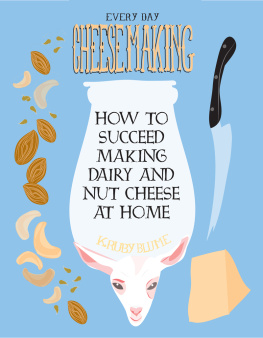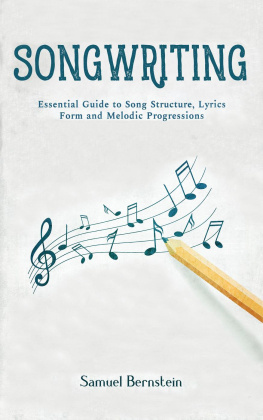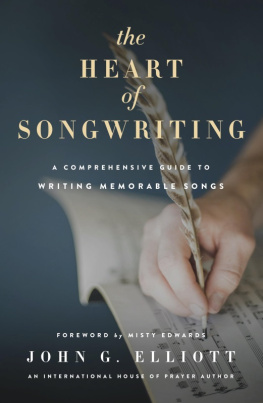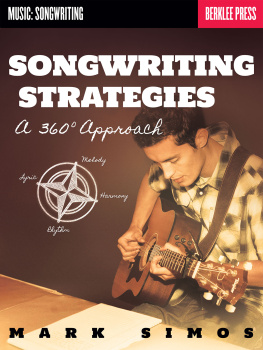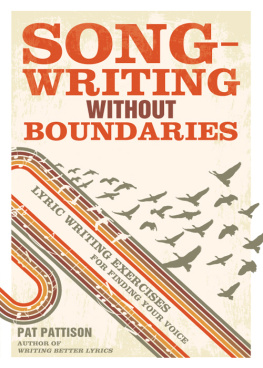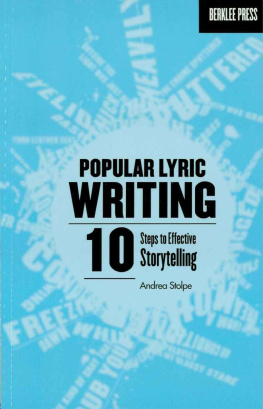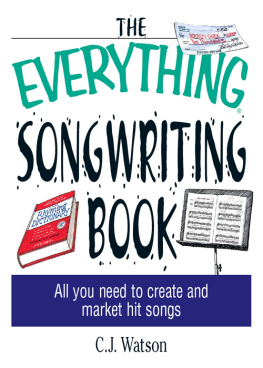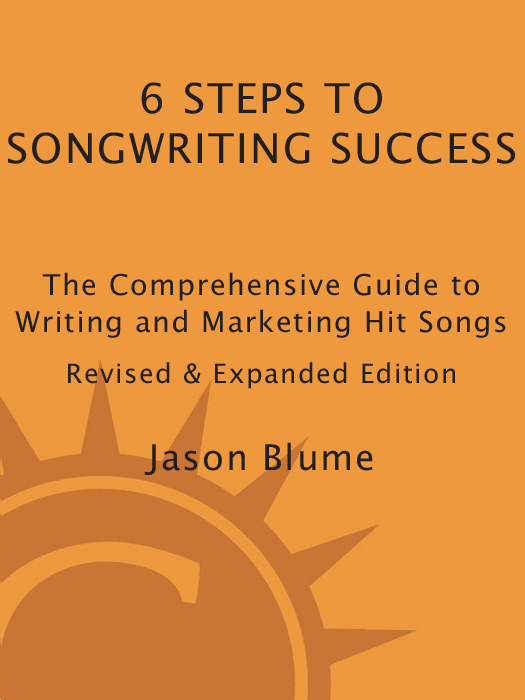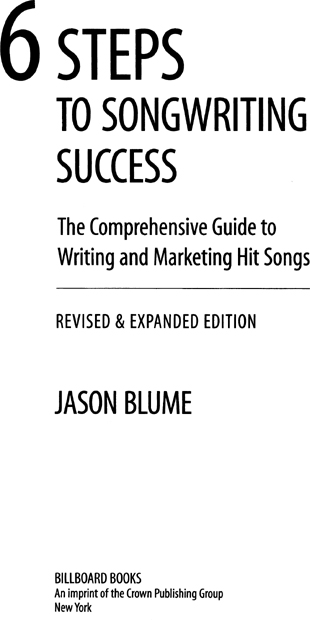Acknowledgments
There are several individuals without whom this book could never have been written. Id like to express my heartfelt gratitude to my Executive Editor, Bob Nirkind, and my Editor, Meryl Greenblatt, whose talents and contributions made it possible for me to write the book I always wanted to write. Im deeply grateful to my literary agent, Rita Rosenkranz, for her expertise and belief in this project. I could never find sufficient words to thank Neil Rice for making everything behind the scenes work so smoothly and for his inestimable contribution to my work and my life.
Thank you to all of my teachers and to Keith Urban, Paige Levy, Janis Ian, Melissa Manchester, Brendan Okrent, Barbara Rothstein, Gloria Sklerov, Harlan Howard, Karen Taylor-Good, Carol Elliott, Buddy Mondlock, Sherrill Blackman, Barbara Cloyd, Greg Barnhill, Tom Luteran, Regie Hamm, Paul Rolnick, Steve Seskin, Alan Brewer, Steve Bloch, Herb Tassin, David Friedman, Wade Kirby, Roger Sovine, Mike Sistad, Wayne Perry, Justin Wilde, Craig Wiseman, Gary Baker, Mark Mason, Bryan Cumming, David Roth, Lee Groitzsch, Janice Cook, Virginia Rice, Jim Cooper, Phil Goldberg, Bart Herbison and staff at NSAI, Wayne Tester, Robert K. Oermann, Tommy LiPuma, Jeff Fenster, Judy Phelps, Allan Rich, Ira Greenfield, Thom Schuyler, Billy Steinberg, Aaron Meza, Franne Golde, Frank Liddell, Teri Muench and Steve Diamond, Marty Wheeler, Judy Stakee, Kathleen Carey, Debbie Zavitson, Jeff Carlton, Jeff Little at Borman Entertainment, Sandy Carothers and Phyllis Austin of Bulls Creek Music, John Van Meter, Steve Weaver, Rick Chudacoff, Steve Gibson, and all of the talented songwriters and music industry professionals who contributed so generously to this bookand especially to Jane Snyder.
I owe a special debt to Michael Hollandsworth, who believed in my talents and taught me how to be a songwriter, and to Britney Spears, Collin Raye, the Backstreet Boys, Leslie Mills, Chris Pelcer, Sherry Kondor, Jesse McCartney, Don and Gayle Goodman, Adam Sandler, Liz Rose, A.J. Masters, Lis Lewis, Stephanie Cox, John and Robin Berry, David Gray, Eric Beall, and all of the others whove contributed so much to my career.
Thank you: Gordon Pogoda (for the musical notation and the wonderful quote); Bryan Cumming for the chartsand for being such a wonderful, talented friend; Amy Smith Heinz for pitching my songs; Mark Mason, Deanna Bruton, Michelle Andrade-Wright, Gabrielle Hoffman, Julie Jarett, and the staff at BMI; Michael Laskow, Michael Lederer, Doug Minninck, and the staff at Taxi; and Penny Nichols at SummerSongs for giving me the opportunity to do the thing I love the mostteach developing songwriters.
Id also like to acknowledge Camilla Kleindienst of Banner/Planet Happy Publishing and Dave Olsen and Hope Chirino of Warner Bros. Publications for their patience and cooperation (beyond the call of duty) in helping me to secure permissions to reprint the lyrics contained in this book.
Thank you to Debbie Chessor for your valiant effort to make me look like Im nineteen in the photo. And a very special thank you to Claire Ulanoff; Wayne Moore; Ruth Rosen; Renee Lopez; Marvin Werlin; Andrea Horstman; Mark Werlin; Coreen Davis; Maris, Mark, Jamie, and Adam Goldberg; Alana Amadeo; Todd and Laura Serinsky; Leslie Brenner; Hal Holzer; Carol Elliott; Katy Garvey, for your continued love and supportand to my first collaborator and biggest supporter, Maureen Custer, who listened to my struggles and encouraged me more than shell ever know. And to Opie, Duncan, and Coin (the cats) who sat on my lap, my desk, and my computer, providing unsolicited editorial advice.
And a final heartfelt thank youto the source from which all creativity flows.
Contents
CHAPTER 1
CHAPTER 2
CHAPTER 3
CHAPTER 4
CHAPTER 5
CHAPTER 6
CHAPTER 7
CHAPTER 8
CHAPTER 9
CHAPTER 10
CHAPTER 11
CHAPTER 12
CHAPTER 13
CHAPTER 14
CHAPTER 15
CHAPTER 16
Introduction
Since the first publication of 6 Steps to Songwriting Success: The Comprehensive Guide to Writing and Marketing Hit Songs in 1999, dramatic changes have taken place in the music industry. The manufactured, synthesizer-driven teen pop that ruled the charts from the mid- to late 1990s has been replaced by more guitar-oriented, alternative rock and pop, while hip-hop has crossed over from the urban charts to dominate the Top 40 airwaves and increase its hold on listeners. In addition, solo singer-songwriters are back in vogue again, and country music has experienced a marked shift from slick pop-influenced sounds to more organic, traditional-sounding songs, artists, and production. As Sonny and Cher sang, The Beat Goes On, and soon many of todays superstars and their songs will be relegated to bargain bins and oldies stations as a new generation of artists and music assumes prominence.
Changes in the business of music have been even more dramatic. The advent of MP3s, digital downloading, and hard drive recording technology; the demise of cassettes as the primary format for pitching songs; and the consolidation and closure of numerous record labels and music publishers have altered the landscape for songwriters and recording artists at every stage of their career development. Most notably, the rampant downloading of shared songs via the Internet has led to tremendous losses within the music business, and the issues of how to compensate songwriters and recording artists for downloaded music and how record labels can survive in the current marketplace remain in flux. The good news is that, despite it all, there are still outlets for truly great songs with exceptional melodies and lyrics that touch listenersand I believe there always will be.
The primary focus in this books first edition was on learning to write and market the sorts of songs recorded by artists who typically do not create their own material. This outlet has shrunk considerably. Todays songwriters need to be increasingly aware of the necessity of finding an inside track, cowriting with artists and producers, and writing songs that can fill slots artists and producers are unable to fill. They also need to understand that there are fewer opportunities for writers who only write songs, as opposed to those who wear the hat of artist or producer as well. This updated and expanded edition focuses on both of these issues, as well as on how to thrive in todays challenging marketplace, where I suggest alternative avenues to generating income from our songs.
Since writing 6 Steps, Ive taught more than a hundred workshops, and Ive listened to the concerns and feedback of thousands of songwriters. Much of the first edition has been rewritten to address their questions and the issues that are important to them. Addressed too are the unique considerations of artists who are writing songs for themselves, or for their own self-contained bands, to perform and record.


